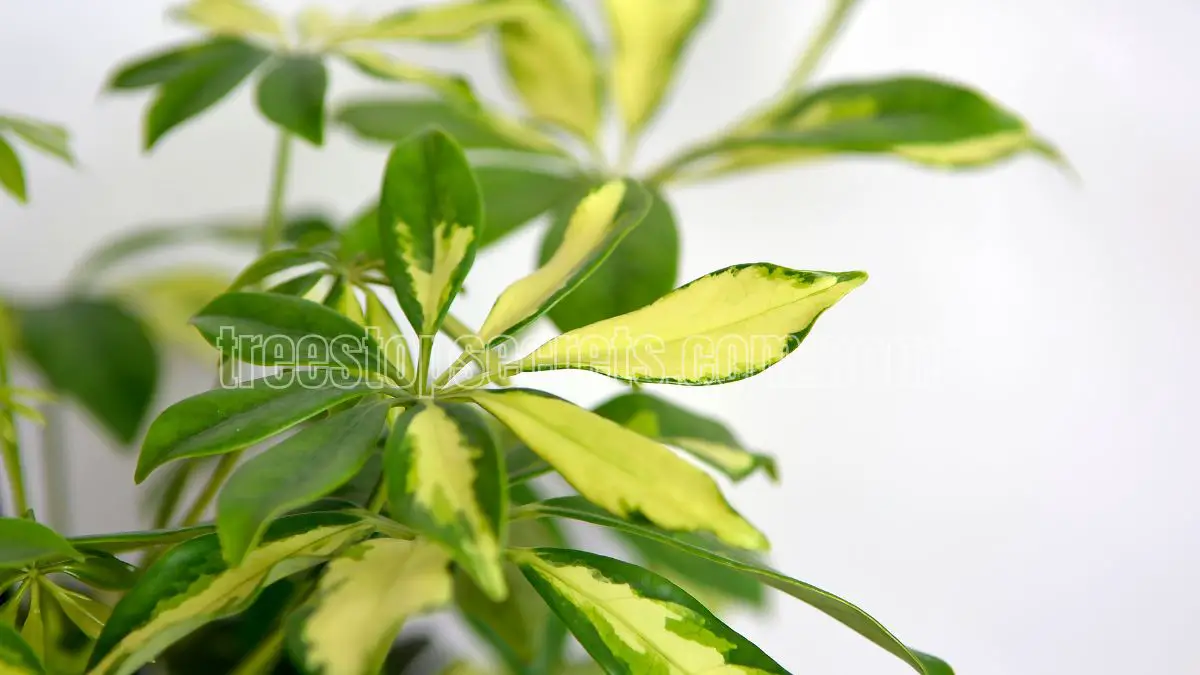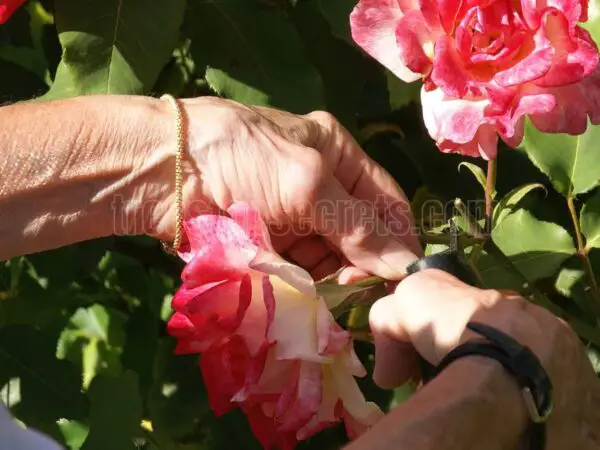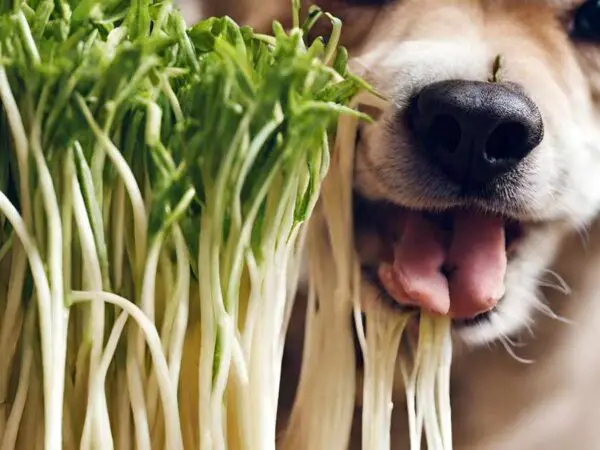Schefflera care is all about providing just the right conditions for this easy-to-please but extremely popular houseplant with its attractive glossy leaves. Here’s how to care for schefflera and give it the right amount of light, water, and humidity.
These ingredients are key to allowing your plant to flourish inside your home. They generally like bright, indirect light and need watering when the first inch of soil is dry to the touch.
Providing a consistently warm space with higher humidity levels encourages growth and can reduce problems such as leaf drop. This guide will cover essential tips and practices to ensure your schefflera remains vibrant and resilient, making it a beautiful addition to any space.
Key Takeaways
- Schefflera plants are some of the best houseplants around! Their attractive foliage arrangement and ornamental features add beauty to any interior environment.
- They don’t like direct sun on leaves, so avoid that type of exposure at all costs! To maintain optimal soil moisture, avoiding root rot, water them sparingly.
- Schefflera prefer high humidity and stable temperatures. If you want to increase humidity, we recommend using humidity-boosting techniques, such as misting.
- Regular, strategic pruning and well-timed fertilization will keep this plant healthy, encouraging bushy, fuller growth and avoiding unsightly nutrient deficiencies.
- Stay alert for pests and diseases. With early detection and organic treatments, you can prevent and treat pest problems to maintain a healthy schefflera.
- Adjust your care routine according to if your schefflera is inside or outside. Be aware of seasonal shifts to give your plant the conditions it prefers most.
Understanding Schefflera
Schefflera plants are members of the Araliaceae family, thriving in tropical habitats. Many choose to grow the schefflera houseplant indoors due to its low upkeep needs. Renowned for its dramatic, large leaves and easy-going nature, this popular houseplant is perfect for adding lush foliage to any home or office.
1. What is Schefflera?
Schefflera plants are known for their unique, lustrous foliage leaves, which in mature specimens often grow palmate, or fanned out, like the spokes of an umbrella. These large glossy leaves are produced in whorls, giving it a unique architectural form.
In their native environment, mature schefflera can reach heights of 25 feet. When growing them indoors, most people keep them trimmed down to about 6 feet. The genus includes over 900 species, including popular houseplants Schefflera actinophylla and Schefflera arboricola, both of which have distinct characteristics.
2. Common Names and Varieties
Known often as the umbrella tree or dwarf umbrella tree, schefflera has a few popular varieties. Schefflera Amate is known for its broad, glossy foliage.
By contrast, Schefflera arboricola is adored for being relatively small. Additionally, variegated varieties have become increasingly popular among enthusiasts for their striking leaf patterns, providing additional visual interest to indoor spaces.
3. Native Habitat and Climate Preferences
Schefflera is native to areas such as Australia and New Guinea, where it grows in warm, wet, tropical environments. This history lays the foundation for its care.
A schefflera likes it shady and warm, staying above 60°F. Though it puts up with the typical indoor humidity of about 30%, it thrives at 40%. Watering matters. Overwatering and underwatering can both cause leaves to yellow or develop spots.
Essential Care Requirements
Whether you want to grow a healthy schefflera houseplant indoors or outdoors, knowing these essential schefflera plant care requirements is key to your success. Basic requirements include the amount and quality of light, water, humidity, temperature, and the type of soil. By giving these fundamental factors the proper care and consideration, brilliant life and lasting prosperity are guaranteed.
1. Optimal Light Conditions for Growth
Schefflera does best in bright, indirect light, so it’s a good choice for spots near east or west-facing windows. Bright, direct sunlight will burn this plant’s leaves, causing ugly brown patches.
Giving your schefflera a bright room, but not in direct sunlight, will keep the leaves healthy and vibrant.
2. Watering Techniques Throughout the Seasons
During the active growing season, water your schefflera thoroughly, then let the soil dry out completely before watering again. This careful balance allows us to avoid root rot.
Monitor soil moisture weekly to keep your plants happy and healthy. Change your watering routine with the season, watering less often in the winter months.
3. Humidity Levels and Their Importance
Schefflera thrives in moderately high humidity, so keeping this requirement will help keep the plant healthy and growing. With lower humidity, leaf tips could brown or curling may occur.
Raise humidity levels by misting plants or putting a pebble tray with water next to them.
4. Ideal Temperature Range for Schefflera
Schefflera generally does best in temperatures ranging from 65°F to 90°F. Although it is able to withstand cooler temperatures, do not expose it to cold drafts or temperatures lower than 50°F.
Providing a consistent, warm indoor environment will encourage growth.
5. Soil Mix and Repotting Practices
A quick-draining soil mix is essential for schefflera. Consider what’s included in your soil mix. Look for things such as peat, perlite, and bark.
Repot each year or whenever it outgrows its pot, giving the plant new soil and a chance to examine the root system for rot or other problems.
Nutritional Needs and Fertilization
The overall health of schefflera plants is greatly impacted by their nutritional needs and fertilization. Nitrogen, phosphorus, and potassium, sometimes referred to as the essential nutrients, are essential for healthy plant development. They encourage robust growth, lush canopies, and stress tolerance.
When nutrient availability is poor, sometimes the problems are easy to spot, like when plant growth is stunted or leaves start changing color.
1. Recognizing Nutrient Deficiencies
Typical indicators of nutritional needs in schefflera are yellowing leaves, especially the lower or older leaves. Telling apart these symptoms from other issues, such as overwatering or insects, takes close attention.
For example, if the leaves start yellowing but are still firm, that’s probably a sign of low nitrogen levels. To amend nutrient imbalances, apply a balanced fertilizer.
Or you can add organic amendments such as compost or coffee grounds directly to the soil.
2. Effective Fertilization Strategies
Schefflera responds well to both liquid and granular fertilizers. An all-purpose organic houseplant food should be used during the growing season, which lasts from March through October.
Fertilize at least once a week (no more than twice weekly) during this zealous growth phase, and apply following the manufacturer's guidelines for use. Keeping an eye on plant response following fertilization will be key to understanding the effectiveness and making any necessary changes.
3. Best Practices for Feeding Schefflera
- Water in fertilization of schefflera plants 1-2 times a week while growing in spring/summer.
- Providing adequate nutrition Provide a planting mix that is well-draining and loamy, and repot every year.
- Avoid over-fertilization, as it can harm the plant.
Observing the schefflera houseplant's response to fertilization will help you make adjustments to care accordingly.
Common Problems and Solutions
All schefflera houseplant owners face their own set of unique challenges. Learning about these common problems can improve the care you provide for your schefflera plant and help you keep it healthy and happy! By recognizing initial indicators, using preventative strategies, and setting up a solution process, owners can be successful in protecting their lush foliage.
1. Identifying Early Signs of Pests
Common nuisances such as mealybugs and spider mites infestations can destroy schefflera. These early signs include sticky residue left on leaves, tiny webs, or knowing that the insect is visible.
Frequent inspections, preferably every two weeks, allow the PCO to identify and treat new infestations before they develop into larger ones. Inspect thoroughly, especially the undersides of leaves, as well as where leaves attach to stems and other areas pests like to hide.
2. Organic Treatments for Pest Control
Keeping pests under control is essential for the health of your Schefflera. Organic treatments, like insecticidal soap, should be your first line of defense for pest management.
These organic treatments are safe for use indoors and will not harm the beneficial pollinators like bees. To use, dilute the soap according to the instructions on the package. Apply it as a spray on the affected areas, and reapply this solution every 2-3 days until the issue improves.
3. Diseases Affecting Schefflera and Their Remedies
Root rot and leaf spot are common diseases that afflict Schefflera, generally a result of overwatering or lack of air circulation.
Root rot manifests with yellower leaves and a bad smell. Conversely, leaf spot is characterized by dark lesions on the leaves.
To solve these problems, provide good drainage, water at the right intervals, and increase airflow by giving plants enough space.
Pruning and Propagation Techniques
Pruning and propagation are essential practices that help keep your schefflera healthy and beautiful.
PruningRepetitive pruning will help control the size of the plant and create a fuller plant.
PropagationPropagation will enable you to grow your collection or share plants with friends!
1. Tailoring Pruning for Healthy Growth
To promote bushy growth in schefflera, consider these techniques:
- Trim back leggy stems to encourage new growth.
- Pinch off the tips of branches to stimulate branching.
- Remove any dead or yellowing leaves to maintain vitality.
Knowing what stems to prune is no-brainer. Additionally, prioritize stems that are straggly or weak, because by cutting these back you’ll encourage the growth of thicker, more vigorous shoots.
Remember to always use clean, sharp tools to avoid spreading any diseases and keep your plant healthy.
2. Comparing Propagation Methods
Schefflera can be propagated through stem cuttings or division of the clumps. Stem cuttings, especially from vigorous stock plants, tend to root with more success.
Though division works well for more mature plants, the roots need to be very carefully managed. The secret is that each method loves well-draining soil and bright indirect light.
3. Best Practices for Successful Cuttings
For successful schefflera cuttings, follow these tips:
- Make cuttings with a very sharp knife or razor blade, taking stem cuttings that are 4 to 6 inches long.
- Retain several leaves on each cutting to facilitate photosynthesis.
- Ensure cuttings are placed in a warm, humid environment.
Step 6 — Monitor cuttings for growth. This is an important step.
Sign of success: Watch for signs like new leaf growth or visible root development, suggesting that your cutting has taken root.
Environmental Considerations
Taking care of the schefflera plant means knowing its surroundings, whether you grow it as a popular houseplant inside or outside. Each environment, whether it’s the outdoors, classroom, or home, comes with various challenges that can affect its development and wellness.
1. Indoor vs. Outdoor Care Requirements
Schefflera plants do well indoors, in bright, indirect light. They need more humidity than most plants, which is easy to provide by regularly misting them or running a humidifier.
Outdoor schefflera loves filtered sun and will burn in the hot direct sun. Temperature changes are particularly harmful for plants meant for outdoor care. These plants are better suited for stable, warm environments.
If you move schefflera from one environment to another, do so gradually to prevent shock, making sure that the conditions are stable throughout the change.
2. Adapting Care to Different Living Spaces
For apartment living, space is at a premium. Adapt care by planting in smaller pots with good drainage to avoid overwatering.
Evaluate the available light: north-facing windows provide lower light, while south-facing ones offer brighter conditions. For homes with more open environments, try locating schefflera in bright locations, but allow plenty of space for the plants to expand.
Vertical gardening techniques can be employed to maximize space regardless of the size of indoor living environments.
3. Seasonal Adjustments for Optimal Growth
- Spring: Fertilize monthly to support new growth.
- Summer: Increase watering frequency as temperatures rise.
- Fall: Reduce water and fertilizer as growth slows.
- Winter: Maintain minimal water and ensure adequate light.
Keeping a pulse on environmental changes year-round is key for your schefflera houseplant. Acclimate the schefflera plant to seasonal changes by slowly adjusting light and watering to accommodate the new environment.
Innovative Care Tips
Innovative care tips for your schefflera houseplant can help you maximize its beauty and health. These techniques encourage the lush foliage and enhance the aesthetic value of the plant in interior environments.
1. Unconventional Practices for Healthier Plants
Taking a chance on some unconventional practices will yield healthy schefflera. Adopting a method known as “pruning for shape” promotes bushier leaves. It increases air circulation around the plant, decreasing the chance of pest infestations.
For stubborn seeds, try the “water soaking method.” Soak the plant in water for a short time to make sure it is really well hydrated. Additional benefits from these approaches can be better overall health and a more colorful look.
See how your schefflera thrives with these creative care tips. This observation will help you identify exactly what it needs, so you can tailor your practice to go the extra mile.
2. Integrating Smart Technology in Plant Care
Using smart technology to automate your plant care will make monitoring your schefflera’s temperature, light, and other conditions easier. Tools such as soil moisture sensors let you know when your plant needs watering, so you avoid the risk of over- or under-watering.
Smart grow lights can automatically adjust based on the natural light in your space, so your schefflera will always get the light it needs. So incorporate smart technology into your care routines!
Put watering reminders on your phone and download an app that lets you log and track when they grow so you can notice patterns. This approach makes care more efficient while encouraging a more meaningful relationship between the plant and their caregiver.
Preventive Care Practices
Inspect your schefflera often to keep it healthy and free of disease. For one, it prevents pest and disease pressure. Performing simple, preventive care practices will go a long way toward keeping your plant healthy and thriving for years to come.
This part covers some practical strategies and a helpful checklist to make sure your schefflera gets off to a great start.
1. Overwintering Strategies for Schefflera
To successfully overwinter your schefflera indoors, consider the following strategies:
- Put it in a sunny location, out of the path of cold air.
- Maintain indoor temperatures above 60°F to prevent stress.
- Use a humidifier or pebble tray to increase humidity.
In winter months, it’s important to keep your schefflera safe from cold air drafts. So be sure you’ve sealed all windows and doors tightly. Monitor light levels.
Schefflera needs bright, indirect light to thrive year round, including overwintering indoors. Be mindful to monitor humidity levels, since indoor air often dries out in winter.
2. Routine Maintenance for Longevity
Routine preventive care encourages long-term health of schefflera plants. Consistent watering is important, but make sure the soil dries out just a little each time before watering again so your plants don’t develop root rot.
Check your plant every week for common pests such as spider mites and mealybugs. Early detection is key!
A checklist for routine care includes:
- Water when the top inch of soil is dry.
- Dust the leaves to enhance photosynthesis.
- Fertilize every few months during the growing season.
Conclusion
With the right schefflera care, you’ll have a beautiful, flourishing plant that will add life to any environment. Just make sure you’re giving it the right amount of light, water and nutrients to keep this showstopper looking glamorous. Preventative measures Regular checks for leafs and other pests and addressing those issues early can save your plant from further damage. Pruning will prevent the schefflera from growing too tall and encourage bushy, vigorous growth. Propagation is a great way to spread your enthusiasm for this special plant to others! Establish a care routine that suits your needs and lifestyle, and relish the experience of raising this stunning plant. Give your schefflera proper care and it will thrive. Discover the joy and fulfillment it brings. Begin today and see your schefflera flourish!
Frequently Asked Questions
What is a Schefflera plant?
Schefflera, or umbrella tree as it’s commonly called, is a popular houseplant prized for its high gloss foliage and low maintenance. This fast-growing schefflera plant can grow up to 10 feet tall indoors, adding a striking touch to your home or workplace with its lush foliage.
How often should I water my Schefflera?
Water your schefflera houseplant once the topsoil is dry about an inch down. This will usually translate to every 1-2 weeks, but you’ll want to consider the specific conditions in your home, like humidity and temperature.
What light conditions do Schefflera plants prefer?
Schefflera houseplants can survive in lower light conditions, but for optimal growth and lush foliage, they thrive with more light exposure.
How do I fertilize my Schefflera?
Fertilize your schefflera houseplant every 4-6 weeks during the growing season (spring and summer) with a balanced, water-soluble fertilizer to encourage healthy growth and lush foliage throughout the whole plant.
What are common pests that affect Schefflera?
Common pests like spider mites, mealybugs, and scale can affect your schefflera houseplant. To prevent these common pests, regularly inspect your schefflera plant and treat infestations with insecticidal soap or neem oil.
How do I propagate a Schefflera?
You can propagate the popular houseplant, Schefflera, with stem cuttings. Simply cut a healthy stem, submerge it either in water or plant it directly into soil, and warm, humid conditions will encourage roots to grow.
What should I do if my Schefflera leaves are turning yellow?
Yellowing leaves on your schefflera houseplant can indicate overwatering, underwatering, or insufficient light. Monitor the soil moisture and light conditions to ensure proper schefflera plant care and revive your plant.
Image Source: Paid image from CANVA




